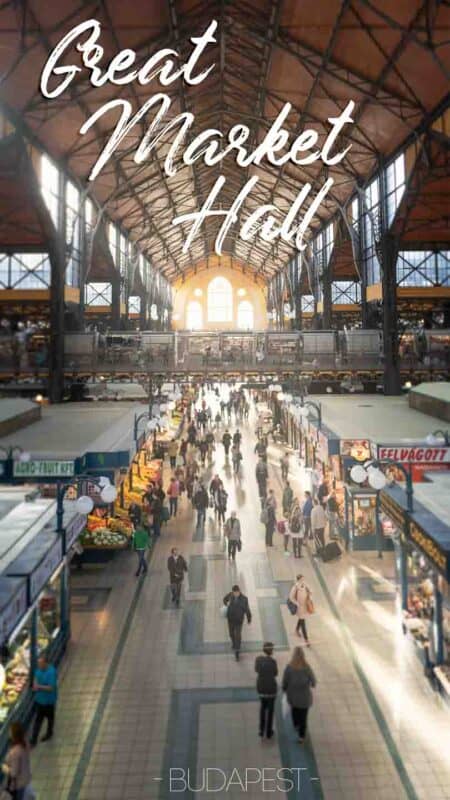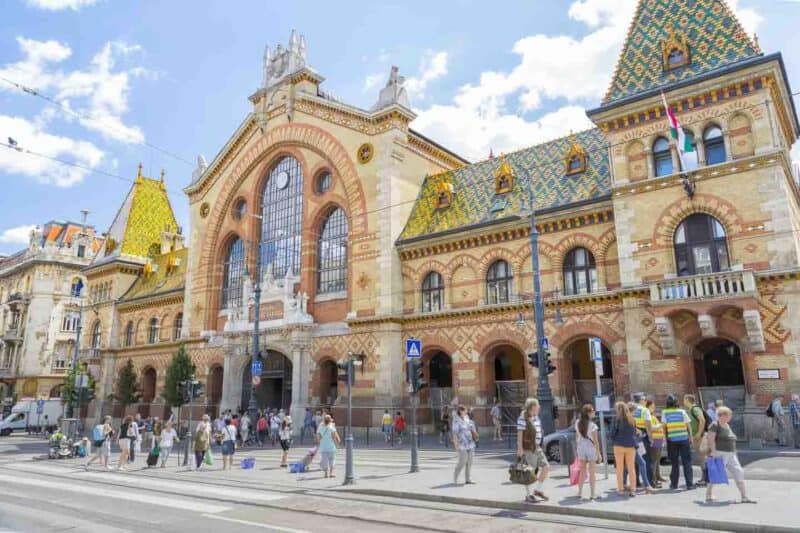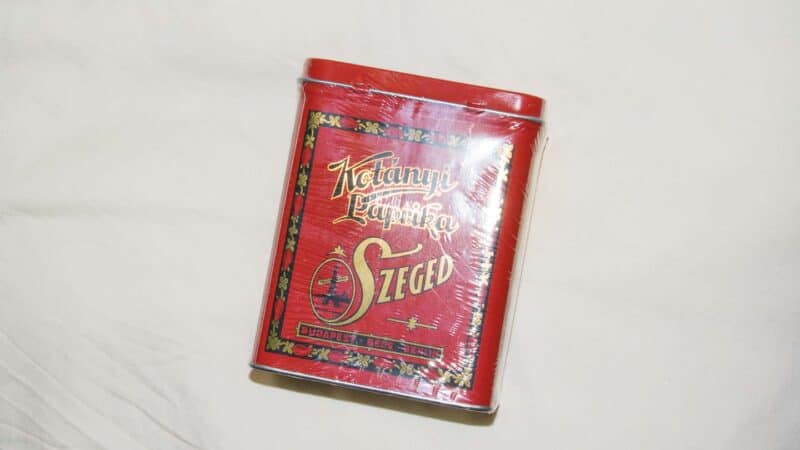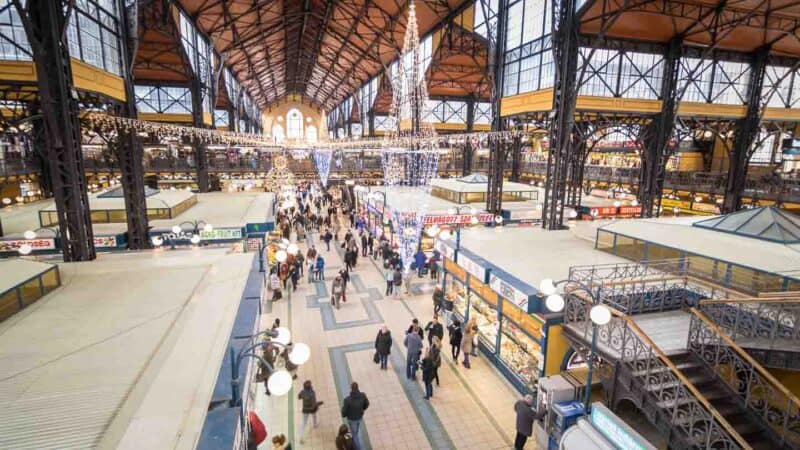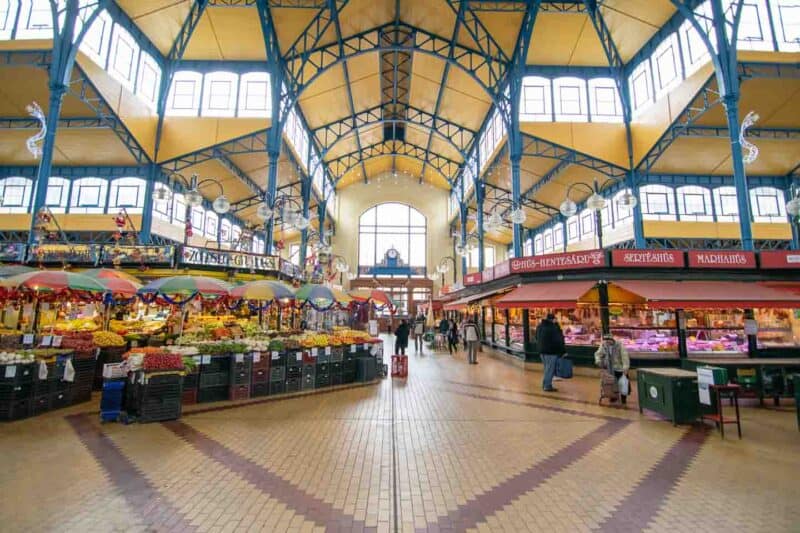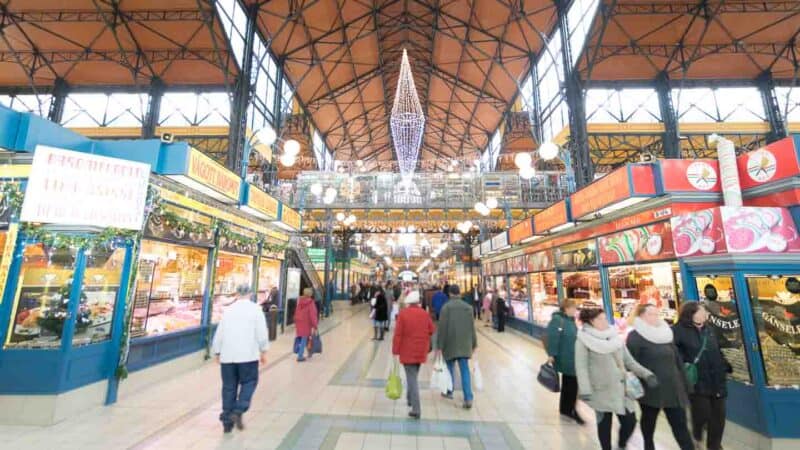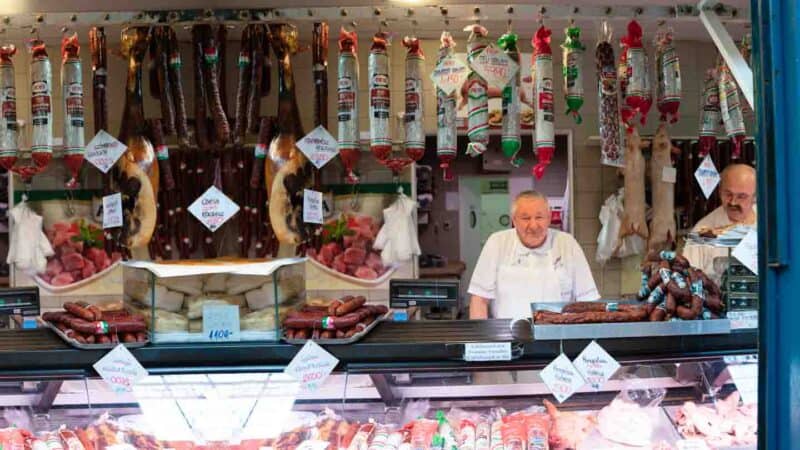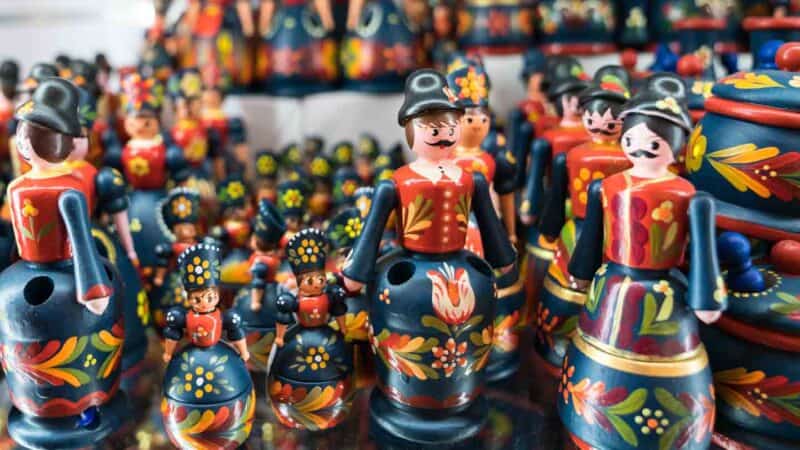We asked our friend and local tour guide in Budapest to show us how to tackle the Great Market Hall. She breaks it all down – where to shop, what to buy, and more importantly, what not to buy here at the Great Market Hall.
While in recent years, the Great Market Hall has become a top tourist attraction in Budapest, there are still some amazing food experiences you need to have while visiting Budapest.
There are a few names for the market, but it’s most widely known as the Great Market Hall. However, you may hear it also called the Central Market Hall, and the local name for it is either Nagyvásárcsarnok or Vasarcsarnok.
- Address: Budapest, Vámház krt. 1-3, 1093 Hungary
- Market Hours: Mon 6 AM–5 PM | Tues-Fri 6 AM–6 PM | Sat 6 AM–3 PM | Sunday Closed
*When looking for the best price and biggest selection of hotels in Budapest, check prices on Booking.com. We’ve found they are the best option and have a great cancelation policy.
Best overall hotel in Budapest – Kempinski Hotel Corvinus Budapest
We stayed at the Kempinski Hotel and loved it for so many reasons, but one of the best is there is a Christmas Market right out your door. From our room, we could see down onto it. It’s also one of the best locations to stay in.
A Local’s Guide to Budapest’s Famous Great Market Hall
When most visitors first see the impressive Great Market Hall, they always seem to ask, “Was it built as a train station?”. Although the structure of this gorgeous building is very similar to classic train stations, the answer is no.
It was built as foodie heaven in the magical year of the Millenium (the 1,000 anniversary of Budapest), 1896, when Budapest was growing as fast as Chicago, becoming one of the most modern cities in Europe. And such a modern city couldn’t allow chaotic open-air markets anymore!
It was time for a change. Thus, the first covered markets of Budapest were born. It’s the best spot to pick up some traditional Hungarian dishes ingredients all in one spot.
Locals Favorite Stalls & Areas
Although the Great Market Hall – or Central Market – is a favorite of travelers because of the breathtaking sizes and architecture, locals still love shopping here too! You just have to know which stands to pick!
Here are some of the local favorites:
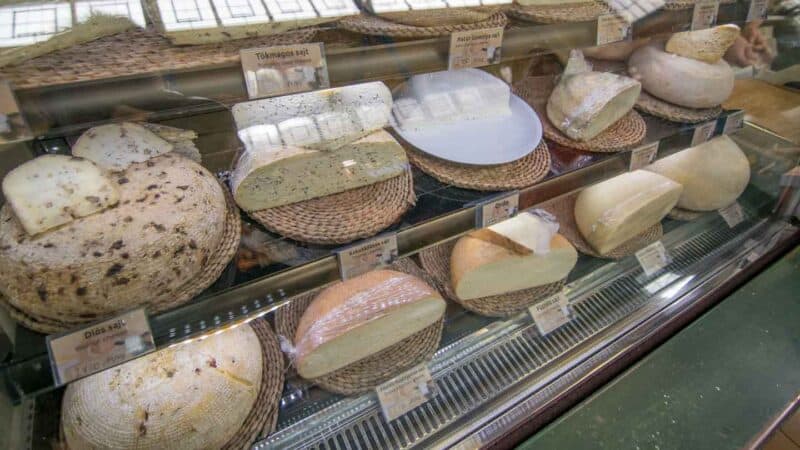
- “The Cheese Place” – When you enter the main gate, you’ll see three long corridors. Right there on the right-hand side, there’s a stand that locals just call the cheese place: they have a huge selection of cheeses from all over Europe and loads of random food items close to the expiration date, which means really low prices and of course a huge queue. Think of buffalo mozzarella for a dollar!
- “The Lavender Stand” – You can’t miss this stand filled with all sorts of purple goodness!
- “The Truffle Shop” – Another must-stop if you like the finer things in life is the truffle shop, where you can find some very affordable (relatively) truffles locally foraged.
- “The Row of the Poor” – Here, you’ll find many stalls selling fresh local produce and other local goods.
Related Article: Traditional Hungarian Foods To Try in Budapest
Things you should buy at the Great Market Hall
- Paprika – Hungarian’s favorite seasoning, is sold all over the market and makes for a great souvenir to bring back for a foodie friend or loved one.
- Honey
- Black Truffles
What not to buy here:
Most things are great, but there are a few things to avoid around here. What they often call saffron seems to be crazy cheap. Well, that’s not saffron but safflower. It gives the same yellow color but not the same flavor.
You’ll also see tubes of “goulash cream” and “paprika cream” – those are products that stayed with us from the Communist times when they loved convenient processed food. All you need is good quality paprika, don’t buy the preservatives with it.
How to Paprika at the Great Market Hall
When buying paprika, keep this in mind: if it’s too pretty packaging, the quality of the paprika might not be so great. If you plan to cook with it, look for plain red paper or see-through plastic bags. They are the homemade goodies that locals buy.
Paprika doesn’t last forever. You should use it within a year and keep it in a dark place. When you cook with it, don’t just sprinkle some on top of your dish. Paprika is a bit like Indian spices. It has to meet the hot oil or fat to really release the flavor.
That’s why there’s a classic joke: Hungarian cooks would chop some onions, and start to cook it on some pork lard (yup, no silly olive oil in good old Hungarian kitchens). When it’s transparent, they add the paprika, and then they start to think about what to cook that day. There are two main types of paprika: hot and sweet.
We recommend you use mainly the sweet and add maybe just a little bit of the hot version if you like your food spicy. Otherwise, you will breathe fire. In recent years, smoked paprika became more and more popular as well. After all, Hungarians love smoked meat and cheese, so why not combine their two favorite flavors?
Related Article: Ultimate Guide To Budapest’s Jewish Quarter
How to Navigate the Great Market Hall
This magnificent building is 10,000 sq meters which are more than 100,000 sq feet with hundreds of stalls.
As a visitor, it can be hard to know where to start. Here we have broken down row by row and area of the market what you can find where and the best spots for everything.
The “Row of the Rich”
If you’re looking for cherries from Chile in December, head to the right corridor that Budapesters call the “row of the rich.” This is where most exotic and imported fruits and veggies are sold all year round. Nowadays, many stands cater to tourists: tons of paprika and other typical Hungarian delicacies.
In the middle of the “row of the rich,” you will stumble upon a very purple stand. They sell lots of lavender products, and Hungary might not be as famous for this wonderful flower as Provence, but actually, a lot of it grows around the country, often around monasteries as well.
The same vendor sells fantastic homemade jams as well, and they are happy to give you a taste. Make sure to try the pure plum jam without any added sugar that sometimes they cook for an entire day on an open fire. Fantastic flavor and great for digestion!
It’s the jam that you can find in many Hungarian desserts as well. If you are looking for something special, ask for a spoonful of the lavender jelly or the rosehip jam, and if you want to try another local favorite, get the apricot. Perfect on the Hungarian-style donuts!
Continuing your adventure on the same corridor, you’ll also find a truffle shop. The mushroom kind, not the chocolate! Truffle, especially the black type, is quite common in Hungary, and it’s much more affordable here than in Italy, for example.
They also let you sample some truffle-flavored products like pesto, oils, jams, or honey. A great edible souvenir for your gourmet friends!
Speaking of honey, Hungary is among the top producers in the world, offering excellent quality and a great variety. On the same row, you can meet several honey vendors, and they are used to travelers with hand luggage, so you can buy tiny jars as well that are allowed on the plane.
Acacia honey is the most appreciated varietal, but we recommend you try a few different types and compare the rich flavors.
Related: Gorgeous Castles in Hungary to Visit
Great Market Hall Back Section
After the end of the corridor, you can enter the back section of the market. First, on the left, you’ll find a little room decorated with mushroom pictures. They don’t sell mushrooms. They examine them. Think of it as a mushroom office!
The experts check each and every piece that you bring to them after foraging in the woods to make sure they won’t poison you. It’s a great service provided in many markets all over the country – that’s why mushroom hunting is pretty safe in Hungary! And wild mushrooms are always tastier.
This back section hosts the real farmer’s market a few times a week. It’s the busiest on Friday and Saturday. The rest of the market is only for resellers, but these few stands are for the farmers who bring out their seasonal produce.
In one corner, you can even find fresh artisan cheese and raw milk to buy! If you are interested in tasting the milk but don’t want to buy a full bottle, you can get a taste of it in a glass for just a few forints.
The Middle Corridor of the Great Market Hall
Let’s go back to the main area! The middle corridor is the widest, and it has a mixed selection: meat, veggies, fruits, and some stands aimed at tourists.
The “Row of the Poor”
If you want to meet most of the local shoppers, go to the other side corridor, the one on the left, if you are standing at the main entrance. That’s where they sell mainly local and seasonal produce. Therefore, that’s the most affordable section, the “row of the poor.”
It’s my favorite, to be honest, as I try to shop as local as possible. The best season is from May till October, the rest of the year we need to import more fresh things from abroad, mainly Italy, Spain, and Greece.
Second Floor of the Market Hall
After discovering the main level, let’s have a break on the second floor. You can take the escalators to go up. That’s where you will find a lot of classic souvenirs from embroidery to printed T-shirts and some food vendors to have lunch at.
This upper section is pretty crowded, and you need to have some common sense to avoid the less authentic souvenirs (please, don’t buy anything with a Communist red star on it, it’s not funny).
The food vendors are targeting only the tourists, so the price-quality ratio might not be the greatest compared to other places in the city. One thing to try, though, is the “lángos” (say it as “lung-osh”), kind of like a fried pizza. The classic ways to eat: either with just garlic on top (the purist) or with sour cream and cheese (the decadent).
Every other option they offer here is, well, not so authentic. Especially the sweet lángos. Get a donut or a pancake if you crave something sweet! The queue here can be pretty long, and if you value your personal space, it’s not going to be your favorite place. To avoid it try to get there in the morning and avoid the lunch crowd.
After stuffing your tummy with this filling dish, head to the next vendor and order a shot of “Unicum.” This is one of the classic Hungarian liquors. It comes in an unmistakable round bottle with a cross on the label because – you guessed it – it was invented as a medicine. This miraculous drink has been serving Hungarians’ digestive systems for more than two centuries, and the recipe is still a secret.
All we know is that it contains more than 40 herbs and spices from five continents and that it cures just about every health problem. You are as healthy as a horse? That’s okay. Prevention is also important! Be prepared for something really bitter though, and if you think it tastes like cough medicine, you’re not the first one. You’ll get used to it.
Our recommendation for the start: go with the lighter, sweeter version, Unicum Szilva. It’s the same drink but aged on a prune bed in oak barrels and “only” 35% of alcohol instead of 40. If you get hooked on the drink, we urge you to visit the Unicum Museum just a few tram stops south. The history of the Zwack family that makes it is fascinating. And what better museum experience than having a liquor tasting in the end, right?
The Basement Level of the Great Market Hall
At this point, you might think that it’s one of the largest markets you’ve ever seen, but you haven’t even been to the basement level yet! Let’s take the escalators again, but now going deep down.
The basement hides mainly the stinky stuff (fish and pickles) and the things that don’t deserve to be in plain sight, like a supermarket (that’s open much longer than the market itself if you need emergency food shopping in the evening). Next to the supermarket, you’ll find the best butcher in the whole market, a great place to get those famous Hungarian sausages.
If you follow the corridor, the first thing to find there will be a stand selling kitchen utensils – this is where you can get that special tool called ‘nokedliszaggató’ to make the Hungarian spaetzle (‘nokedli’ or ‘Galuska’), the best garnish with a good beef stew or chicken paprikash.
The rest of the corridor is for meat vendors (including game; hunting and game meat are quite popular in Hungary), pickle stands, and fish shops.
The Pickle is an art form in Hungary and all over Central and Eastern Europe actually. It’s not just the classic cucumbers. You’ll see the most colorful selection here: from cauliflower to baby watermelon, from plums to beetroot. Almost anything can be pickled. Most vendors don’t mind selling you just a small amount or a mix if you want to taste it, and you will love the jars with cute pickled smiley faces or animals (cut out of radish) in them. It’s an easy trick to make kids eat more vegetables. Besides, fermented food is supposed to be super healthy!
At the end of this section, you’ll meet the – usually bored – fish vendors. Hungarians eat very little fish, and most of it is from freshwater, like carp, catfish, or the excellent pike-perch. We have a classic soup made with – of course – loads of paprika, the Fisherman’s Soup, and a classic Christmas dish. That’s why 40% of Hungarian fish consumption happens in the three days of Christmas, and that’s why the only busy time at this part of the market is the week before the winter holidays.
Passing time here in the basement, you might notice something else: a few glass cabinets displaying typical Hungarian products like onion, paprika, or the famous Rubik’s cube. This little exhibition is dedicated to the so-called Hungarikums, all the special things that Hungary is proud of and would like to preserve.
At the bottom of the corridor, there’s a whole room dedicated to our wine as well: a huge map with the 22 wine regions and posters describing the typical Hungarian grape varietals. A must-see for wine lovers!
Save Room for Dessert on the Main Level
By the time you finish discovering all corners of the Great Market Hall, you deserve a dessert! Head to the first level again, and find the Strudel shop in the middle of the main corridor. The Hungarian strudel has thin layers of filo pastry holding together the very rich filling that can be an apple, sour cherry, poppyseed, curd cheese, and more. Yumm!
Currency and other details at the Great Market Hall
A few words about the money. Some vendors accept cards (Visa or Mastercard), but many only accept cash. You can find ATMs and exchange offices within the market, but the ATMs are the ‘Euronet’ ones giving you a very bad exchange rate; just go to a bank before visiting the market. The bank ATMs are usually more reasonable.
The exchange office is okay, but you can find better ones in the city. Wherever you change money, always check the notes you get (look out for other countries’ money), and never change money on the street. Budapest is pretty safe for a big city, but pickpocketing exists.
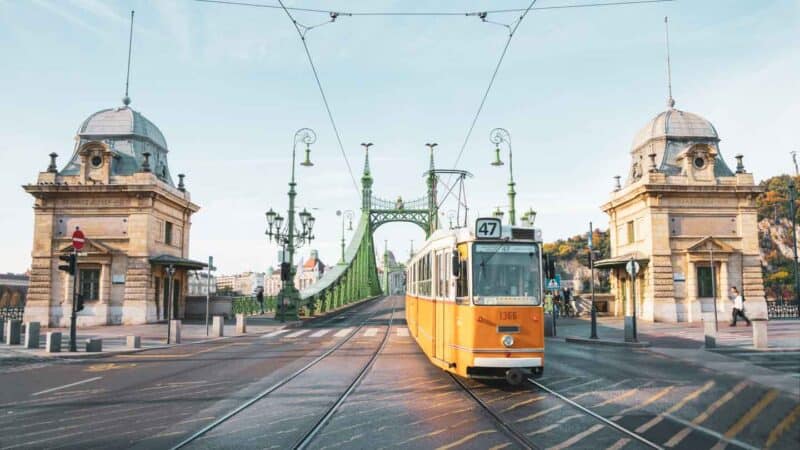
How to get to the Great Market Hall
The Great Market Hall is at the end of the famous Váci shopping street, so you can easily walk here, or you can take the metro M4 or the tram 47 and 49, the stop is called “Fővám tér”, and when you’re here don’t forget to check the beautiful Liberty Bridge stretching over the river!
More on Budapest
Your Insider Guide to the Best Budapest Thermal Baths
An absolutely incredible place to visit, Budapest is one of the prettiest cities in Europe, and no visit to Hungary’s capital is complete without stopping by one of the beautiful…
The Perfect 3 Day Budapest Itinerary
See all of the city’s highlights with this perfect 3-day city guide to Budapest – Day by day in a logical guide for a fun 3 days in Budapest.
Budapest Nightlife Guide | The Best Ruin Bars in Budapest
Given Budapest’s history and its architecture, it’s no surprise that it’s the go-to city in Hungary for tourists. Something you may not know is that Budapest is also known to…
Don’t Forget to Pin Me for Later!
